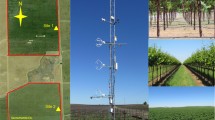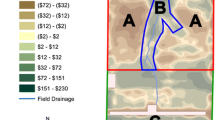Abstract
The field of precision agriculture has brought the concept for “big data” to farming by bringing sensor technology into the field allowing growers to make more efficient management decisions. However much of the research and practice of precision agriculture has focused on soil-related issues while sub-field microclimates have been mostly unstudied despite their known importance to crop production. This study sought to explore the differences in temperature at a sub-field level during an entire season using weather microsensors recording data every minute from 11 Dec 2017 to 11 Apr 2018. Twenty-two cost-effective sensors were placed within a ~ .5 ha area satsuma orange (Citrus unshiu) grove along the Gulf Coast on Baldwin County, Alabama. The sensors were placed in aerated housings in a vertical column on the west face of eleven trees at a height of 1 and 2 m off the ground. We focus on several events where temperatures hovered near 0 °C or near − 7 °C, a temperature known to damage satsuma trees and find that temperatures can vary by as much as 1.5 to 2 °C at the same moment in the same grove. Extreme cold events were also found to be non-uniform within the grove, and the response was seen on a tree-by-tree basis where increased exposure to < − 7 °C temperatures led to increase defoliation (r2 = 0.92) and lower fruit count in the following year (r2 = 0.71). We discuss the implication of these differences in temperature and what it may mean for the future of precision agriculture.







Similar content being viewed by others
References
Andersen PC, Brodbeck BV (2015) Yield, tree size, and fruit quality of mature ‘owari’and ‘brown select’ satsuma on Poncirus trifoliata ‘Rubidoux’ and ‘Flying Dragon’ Rootstocks in North Florida. HortScience 50(11):1650–1653
Andersen PC, Ferguson JJ, Spann TM (2012) The satsuma mandarin. EDIS publication HS.195 University of Florida
Ashraf M, Sanusi R, Zulkifli R, Tohiran KA, Moslim R, Ashton-Butt A, Azhar B (2019) Alley-cropping system increases vegetation heterogeneity and moderates extreme microclimates in oil palm plantations. Agric For Meteorol 276:107632
Asproudi A, Petrozziello M, Cavalletto S, Guidoni S (2017) Grape aroma precursors in cv. Nebbiolo as affected by vine microclimate. Food chem 211:947–956
Austen EA, Sale PWG, Clark SG, Graetz B (2002) A survey of farmers’ attitudes, management strategies and use of weather and seasonal climate forecasts for coping with climate variability in the perennial pasture zone of south-east Australia. Aust J Exp Agric 42(2):173–183
Bobryk CW, Myers DB, Kitchen NR, Shanahan JF, Sudduth KA, Drummond ST, Gunzenhauser B, Gomez Raboteaux NN (2016) Validating a digital soil map with corn yield data for precision agriculture decision support. Agron J 108(3):957–965
Bramley RGV (2009) Lessons from nearly 20 years of precision agriculture research, development, and adoption as a guide to its appropriate application. Crop and Pasture Science 60(3):197–217
Cassman KG (1999) Ecological intensification of cereal production systems: yield potential, soil quality, and precision agriculture. Proc Natl Acad Sci 96(11):5952–5959
Cavero J, Medina ET, Puig M, Martínez-Cob A (2009) Sprinkler irrigation changes maize canopy microclimate and crop water status, transpiration, and temperature. Agron J 101(4):854–864
Chen J, Franklin JF, Spies TA (1993) Contrasting microclimates among clearcut, edge, and interior of old-growth Douglas-fir forest. Agric For Meteorol 63(3–4):219–237
Choi DM, Moh SM, Chung IY (2010) Regional clustering scheme in densely deployed wireless sensor networks for weather monitoring systems. In: 2010 IEEE 12th International Conference on High Performance Computing and Communications (HPCC) IEEE, pp 497–502
Dhillon R, Udompetaikul V, Rojo F, Roach J, Upadhyaya S, Slaughter D, Shackel K (2014) Detection of plant water stress using leaf temperature and microclimatic measurements in almond, walnut, and grape crops. Trans ASABE 57(1):297–304
El-Sharkawy MM (2016) Precision agriculture using advanced remote sensing techniques for peanut crop in Arid Land. Journal of Hyperspectral Remote Sensing 6(1):72–81
Fountas S, Blackmore S, Ess D, Hawkins S, Blumhoff G, Lowenberg-Deboer J, Sorensen CG (2005) Farmer experience with precision agriculture in Denmark and the US Eastern Corn Belt. Precis Agric 6(2):121–141
Geiger R, Aron RH, Todhunter P (2009) The climate near the ground. Rowman & Littlefield
Gladstones J (1992) Viticulture and environment. Winetitles, p 310
Heim R Jr, Dewey K, Anderson M, Leathers D (1990) A December to remember. Weatherwise 43(6):329–332
Julia C, Dingkuhn M (2013) Predicting temperature induced sterility of rice spikelets requires simulation of crop-generated microclimate. Eur J Agron 49:50–60
Kanzler M, Böhm C, Mirck J, Schmitt D, Veste M (2019) Microclimate effects on evaporation and winter wheat (Triticum aestivum L.) yield within a temperate agroforestry system. Agrofor Syst 93(5):1821–1841
Kim HJ, Sudduth KA, Hummel JW (2009) Soil macronutrient sensing for precision agriculture. J Environ Monit 11(10):1810–1824
Kimball SK, Montalvo CJ, Mulekar MS (2020) Evaluating temperature measurements of the iMET-XQ, in the field, under varying atmospheric conditions. Atmosphere 11(4):335
Knox P (2018) Georgia blueberries also affected by frost. University of Georgia Cooperative Extension. https://site.extension.uga.edu/climate/2018/03/georgia-blueberries-also-affected-by-frost/. Accessed 29 July 2020
Köppen W (1900) Versuch einer Klassifikation der Klimate, vorzugsweise nach ihren Beziehungen zur Pflanzenwelt. Geogr Z 6(11. H):593–611
Kottek M, Grieser J, Beck C, Rudolf B, Rubel F (2006) World map of the Köppen-Geiger climate classification updated. Meteorol Z 15:259–263
Lim YK, Schubert SD (2011) The impact of ENSO and the Arctic Oscillation on winter temperature extremes in the southeast United States. Geophys Res Lett 38(15)
Lin BB, Egerer MH, Liere H, Jha S, Bichier P, Philpott SM (2018) Local-and landscape-scale land cover affects microclimate and water use in urban gardens. Sci Total Environ 610:570–575
Google Maps, Maxar Technologies, USGS, USDA. Aerial Imagery. Accessed 29 July 2020
Marais J, Calitz F, Haasbroek PD (2001) Relationship between microclimatic data, aroma component concentrations and wine quality parameters in the prediction of Sauvignon blanc wine quality. South African J Enol Vitic 22(1):22–26
Nagel DJ (2002) Microsensor clusters. Microelectron J 33(1–2):107–119
National Climate Data Center (2020) Daily Climate Reports. Accessed 28 July 2020
Novero RP, O'Toole JC, Cruz RT, Garrity DP (1985) Leaf water potential, crop growth response, and microclimate of dryland rice under line source sprinkler irrigation. Agric For Meteorol 35(1-4):71–82
Oke TR (1989) The micrometeorology of the urban forest. Philosophical transactions of the Royal Society of London. Biological Sciences 324(1223):335–349
Pathak HS, Brown P, Best T (2019) A systematic literature review of the factors affecting the precision agriculture adoption process. Precis Agric:1–25
Paustian M, Theuvsen L (2017) Adoption of precision agriculture technologies by German crop farmers. Precis Agric 18(5):701–716
Peacock JM (1975) Temperature and leaf growth in Lolium perenne. I. The thermal microclimate: its measurement and relation to crop growth. Journal of Applied Ecology 99–114
Pereira GE, Gaudillere JP, Pieri P, Hilbert G, Maucourt M, Deborde C, Rolin D (2006) Microclimate influence on mineral and metabolic profiles of grape berries. J Agric Food Chem 54(18):6765–6775
Reichardt M, Jürgens C (2009) Adoption and future perspective of precision farming in Germany: results of several surveys among different agricultural target groups. Precis Agric 10(1):73–94
Ripley EA, Saugier B (1974) Microclimate and production of a native grassland: a micrometeorological study. Oecologia Plantarum 9:333–363
Robert PC (1999) Precision agriculture: an information revolution in agriculture
Robert PC (2002) Precision agriculture: a challenge for crop nutrition management. Plant Soil 247(1):143–149
Rogovska N, Laird DA, Chiou CP, Bond LJ (2019) Development of field mobile soil nitrate sensor technology to facilitate precision fertilizer management. Precis Agric 20(1):40–55
Scharfetter J, Workmaster BA, Atucha A (2019) Preveraison leaf removal changes fruit zone microclimate and phenolics in cold climate interspecific hybrid grapes grown under cool climate conditions. Am J Enol Vitic 70(3):297–307
Schimmelpfennig D (2016) USDA economic research service-cost savings from precision agriculture technologies on US corn farms. United States Department of Agriculture Economic Research Service
Schultze SR, Sabbatini P, Andresen JA (2014) Spatial and temporal study of climatic variability on grape production in southwestern Michigan. Am J Enol Vitic 65(2):179–188
Schultze SR, Sabbatini P, Luo L (2016) Interannual effects of early season growing degree day accumulation and frost in the cool climate viticulture of Michigan. Ann Am Assoc Geogr 106(5):975–989
Smart RE (1985) Principles of grapevine canopy microclimate manipulation with implications for yield and quality. A review. Am J Enol Vitic 36(3):230–239
Stafford JV (2000) Implementing precision agriculture in the 21st century. J Agric Eng Res 76(3):267–275
Stoorvogel JJ, Kooistra L, Bouma J (2015) Managing soil variability at different spatial scales as a basis for precision agriculture. In: Lal R, Stewart BA (eds) Soil-specific farming: Precision Agriculture, p 37–72
Tamang B, Andreu MG, Rockwood DL (2010) Microclimate patterns on the leeside of single-row tree windbreaks during different weather conditions in Florida farms: implications for improved crop production. Agrofor Syst 79(1):111–122
Van Bavel CHM (1967) Changes in canopy resistance to water loss from alfalfa induced by soil water depletion. Agric Meteorol 4(3):165–176
Vitharana UW, Van Meirvenne M, Simpson D, Cockx L, De Baerdemaeker J (2008) Key soil and topographic properties to delineate potential management classes for precision agriculture in the European loess area. Geoderma 143(1-2):206–215
Zellweger F, De Frenne P, Lenoir J, Rocchini D, Coomes D (2019) Advances in microclimate ecology arising from remote sensing. Trends Ecol Evol 34(4):327–341
Ziolkowska JR, Zubillaga J (2018) Importance of weather monitoring for agricultural decision-making–an exploratory behavioral study for Oklahoma Mesonet. J Sci Food Agric 98(13):4945–4954
Acknowledgements
We would like to thank the Auburn University Gulf Coast Research and Extension Center for their assistance in this study. We also thank the number of students from the University of South Alabama’s 2018 MET/GEO443: Climatology class whose help in maintaining the sensors during the winter of 2017–2018 was indispensable to the study.
Author information
Authors and Affiliations
Corresponding author
Rights and permissions
About this article
Cite this article
Schultze, S.R., Campbell, M.N., Walley, S. et al. Exploration of sub-field microclimates and winter temperatures: Implications for precision agriculture. Int J Biometeorol 65, 1043–1052 (2021). https://doi.org/10.1007/s00484-021-02086-0
Received:
Revised:
Accepted:
Published:
Issue Date:
DOI: https://doi.org/10.1007/s00484-021-02086-0




